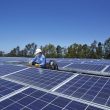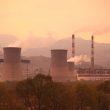Staying safe in a hotter world
It may be the hottest summer many can remember, but because of global warming, it could be among the coolest we will see this century. Record-breaking heat waves began earlier than ever this summer, and the conditions that cause them will only get worse. Right now, about 900,000 Americans live in places that experience 30 or more days per year with a heat index above 105°F. By mid-century that number will grow year by year to 90 million, according to a recent study by the Union of Concerned Scientists.
Enduring such temperatures for an extended period of time is dangerous, even fatal. Extreme heat has killed more people in the last 10 years, on average, than any other weather phenomenon. Heat kills directly, by raising body temperature beyond the limits of endurance (heat stroke); and indirectly, by exacerbating chronic conditions such as heart disease, respiratory illness and diabetes. Older people are especially at risk.
Rising temperatures are now inevitable, because of greenhouse gases already in the atmosphere. And solving this global problem will take unprecedented international cooperation. But there are ways to make heat waves less dangerous right now, which are within the reach of local communities.
For example, communities can provide cool places to escape the heat. That’s what the city of Chicago did, after a 1995 heat wave in which temperatures reached 115°F, killing 739 people. Many of those who died were elderly residents confined to their homes. Chicago has seen many heat waves since, but none with so high a death toll thanks to the city’s emergency response plan. Now, when temperatures reach the danger zone, the city alerts people at risk and opens “cooling centers,” where people can get away from the extreme heat in their homes. Many other cities have since adopted this strategy.
People who must work outdoors are in special need of protection. California, for example, requires employers to provide outdoor workers with fresh water, access to shade and regular rest breaks. During heatwaves, local governments can limit work hours to shifts outside of peak heat periods.
And communities can enact laws requiring landlords to keep their residential properties at a safe summer temperature, just as they are required to provide heat in the winter. For example, Montgomery County, Md., requires landlords to provide air conditioning between June 1 and September 30, maintaining a temperature of 80 degrees or less in habitable spaces.
Montgomery County is an exception. In many places that experience extreme heat, air conditioning is still considered only an amenity, not an essential service. In Arizona and California—states with the hottest areas in the country—landlords must maintain an air-conditioning unit if they provide it, but they are not required to offer it.
Conventional air conditioning is not the best way to keep homes cool. It uses a lot of electricity and transfers heat directly to the surrounding atmosphere, making outdoor temperatures even hotter. Localities can require a better alternative: geothermal cooling, which uses much less electricity and transfers heat into the ground instead of to the air directly outside the building. Its installation costs are higher, but geothermal cuts down electricity bills and can pay for itself in time.
Another strategy is to reduce the amount of air conditioning needed by adding traditional cooling methods that went out of use once air conditioning became widely available. These include reflective roofs, exhaust fans to pull in cooler air at night, exterior awnings over windows and doors, and roll-down wooden slats—popular in European countries—that shield windows during the hottest times of the day. Requirements for providing these simple and inexpensive methods of reducing heat inside homes and other buildings can be added to building codes.
As temperatures keep rising, making safe summer temperatures the landlord’s responsibility can take some of the pressure off the federal government’s Low Income Home Energy Assistance Program. However, there will be more people who have air conditioners but can’t afford to run them during extreme heat spells. Local governments will need more cooling centers and more sources for emergency funding to help people pay their utility bills.
Finally, we can emulate countries where high summer temperatures have been normal for a long time and limit outdoor exposure during the hottest times of the day. Businesses, schools and public buildings can open earlier in the morning, close before peak heat periods and re-open later in the day when temperatures are cooler. Safe working hours can be legislated, and local business organizations can reach agreements about summer hours with their members.
Slowing down climate change is a global priority that requires government agreements and the cooperation of major industries. But there is much that town, cities, and counties can do right now to help their citizens adapt to a hotter, more dangerous world.
Jonathan Barnett is a fellow of the Penn Institute for Urban Research, Professor Emeritus of City and Regional Planning, and former director of the Urban Design Program at the University of Pennsylvania. He is the author of “Managing the Climate Crisis: Designing and Building for Floods, Heat, Drought, and Wildfire,” “Designing the Megaregion: Meeting Urban Challenges at a New Scale,” and, with Larry Beasley, “Ecodesign for Cities and Suburbs,” as well as many other books and articles about city and regional design.
Matthijs Bouw is a professor of Practice in Architecture and Landscape Architecture and the McHarg Center Fellow for Risk and Resilience at the University of Pennsylvania. He is also a founder of One Architecture & Urbanism, an award-winning architecture and planning firm, established in 1995, with main offices in New York City and Amsterdam. His projects in the U.S. include continuing planning work for Climate-Ready Boston and climate-resilience plans for New York City.




















